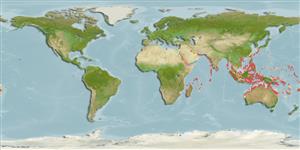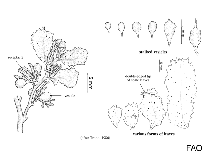Sargassum turbinarioides Grunow
Bell-bladed sargassum| Native range | All suitable habitat | Point map | Year 2050 |

|
| This map was computer-generated and has not yet been reviewed. |
| Sargassum turbinarioides AquaMaps Data sources: GBIF OBIS |
Upload your photos
Google image | No image available for this species;
drawing shows typical species in Sargassaceae.
Google image | No image available for this species;
drawing shows typical species in Sargassaceae.
Classification / Names Common names | Synonyms | CoL | ITIS | WoRMS
Phaeophyceae | Fucales | Sargassaceae
Environment: milieu / climate zone / depth range / distribution range Ecology
Sessile. Tropical
Distribution Countries | FAO areas | Ecosystems | Occurrences | Introductions
Indo-West Pacific.
Length at first maturity / Size / Weight / Age
Maturity: Lm ? range ? - ? cm
Short description Morphology
Holdfast small, discoid; stem short, cylindrical, large at base, slightly tapered to tip, smooth or partly smooth and slightly warty. Primary branches smooth, slightly compressed near base, becoming cylindrical toward upper portions. Leaves coriaceous, obovate, 10mm long, 8 mm wide; stalk very short, almost sessile, with coarse teeth; base (thick) acute, slightly asymmetrical in some; margin coarsely serrate, serrations arranged in single or double rows; distal third of most leaves expanded into a cup-like structure of mainly elliptical to oblong shape when viewed from top view of leaf, resembling the leave structure of Turbinaria; midrib not apparent even at base. Cryptostomata scattered, very apparent, and slightly elevated. Vesicles numerous, some enlarged, up to 12 mm long, 6 mm wide, generally elliptical-oblong or slightly oblong-obovate; stalk very short, less than 1/4 length of vesicle; vesicles irregularly lumpy because of cryptostomata; some vesicles slightly ribbed with or without coronal leaf, those without coronal leaf with a row of coarse spines on upper half. Receptacles irregularly cymose with short, once or twice branched; receptacular branches terete at lower half, slightly compressed toward distal half, with occasional teeth along the margin. Primary branches up to 50 cm in length (Ref. 80758).
Used for human consumption as source of alginate, mainly used as emulsifying, stabilizing and gelling agents in food products such as frozen food, pastries, desserts, jellies, salad dressings, ice creams, meat and flavor sauces, beer, fruit juices, and milk shakes; contains iodine, protein vitamin C, and minerals like Ca, K, Mg, Na, Cu, Zn, S, P, Mn; used as medicine: for goiter, glandular troubles, as antibacteria and antitumor; source of tannins and phenols; also used for animal feeds and fertilizers (Ref. 80758).
Life cycle and mating behavior Maturity | Reproduction | Spawning | Eggs | Fecundity | Larvae
Main reference
References | Coordinator | Collaborators
Guiry, M.D. and G.M. Guiry. 2009. (Ref. 80701)
IUCN Red List Status (Ref. 130435)
CITES status (Ref. 108899)
Not Evaluated
CMS (Ref. 116361)
Not Evaluated
Threat to humans
Harmless (Ref. 80758)
Human uses
Fisheries: commercial
| FishSource |
Tools
More information
Internet sources
BHL | BOLD Systems | CISTI | DiscoverLife | FAO(Publication : search) | Fishipedia | GenBank (genome, nucleotide) | GloBI | Gomexsi | Google Books | Google Scholar | Google | PubMed | AlgaeBase | Tree of Life | Wikipedia (Go, Search) | Zoological Record



